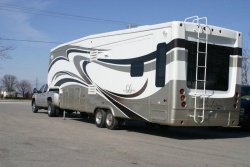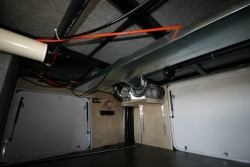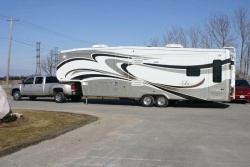 DRV 38TKSB3 Mobile Suite fifth wheel. Click image to enlarge |
Review and photos by Howard Elmer
Find this vehicle in Autos’s Classified Ads
Photo Gallery:
DRV 38TKSB3 Mobile Suite fifth wheel
The 2010 Chevy Silverado 3500-series dually is a serious truck, capable of towing up to 16,200 lb while seating five comfortably in its spacious crew cab. This truck has earned a solid reputation, running the upgraded 6.6-litre Duramax diesel (325 hp and 660 lb-ft of torque) and a six-speed Allison transmission; it was a 1,500-km trip to northern Ontario in the dually that convinced me to try and drop a serious load on it before I had to return it to GM. The ’09 trailer I settled on was a DoubleTree RV, (the company is now known as simply as DRV) fifth wheel, 38 feet (11.6 m) long with triple slides and a dry weight of 14,150 lb (6418 kg).
DRV builds fifth wheels exclusively and it’s important to note right up front that they are anything but cheap. Of course, the word cheap does not only refer to price – in this case it also means that the materials, construction and fixtures used in these units are also anything but cheap. This second reference to overall price is particularly important because much of the money that DRV demands for its units pays for systems that you can’t see, but which for the full-timer will make the difference between a worry-free travel experience and a trip spent dealing with a litany of Mickey-Mouse system repairs.
 DRV 38TKSB3 Mobile Suite fifth wheel. Click image to enlarge |
You don’t have to be a full-timer to own a Mobile Suites, but most will at least spend part of their year using it as a principal residence. This fact makes it that much more important that the interconnected host of mechanical, electric, hydraulic, plumbing, structural and HVAC systems work without issue. Face it: there comes a point where time is more important than money. For these reasons, I decided to try and offer my evaluation of the Mobile Suites from the inside out.
Starting underneath, the trailer is built on a 15-inch (38 cm) steel boxed tube chassis (running off a 12-inch (30 cm) I-beam frame) which is insulated with fibreglass and sealed with a double-layer underbelly. Above the frame (and below the floor) is a vapour barrier, then more insulation between the aluminum floor joists which is covered by 5/8-inch (1.6 cm) plywood and surface flooring. The net effect of that insulation is an R29 rating (note that R-ratings are not just about keeping heat in the unit, but also about keeping it out in summer). The steel boxed frame on the trailer also creates the basement and this design offers a considerable amount of space down there as well. I noted the forward pass-through storage has access from three sides, large doors open to around 130 cubic feet 3.7 cu. m) of space and to minimize stooping, it can be equipped with an optional slide-out tray. Furthermore, I saw while crawling around in there that these inside, out-of-sight spaces are also nicely finished and every wire, tube, line and fastener is properly aligned, neat and secure.
 DRV 38TKSB3 Mobile Suite fifth wheel. Click image to enlarge |
A key feature I noted again and again is the use of vapour barrier and sound deadening material in the walls and roof – and as a four-season unit the fight many RVers are faced with is the danger of water damage – from leaks, certainly, but the more insidious threat is humidity penetration. This is what causes rot and mould in places you’ll never see; instead you’re likely to smell it first. In all the material I was supplied I found references to fiberglass, aluminum, vinyl and foam materials used in the floor walls and roof – all sealed with vapour barriers. Together these sandwiched materials offer an R25 rating overhead and the walls, which are 3.25 inches (8.3 cm) thick, have an R13 insulation rating. DRV also points out that all its wooden components – like the floor – are bolted and screwed; no staples are used. This is a feature that shows off its worth after the first thousand kilometres on the road – staples can shake loose. The outside finish is gel-coated fibreglass with automotive style one-piece front and rear caps. The rear cap also has a detachable ladder and features automotive style hi-visibility LED lights.







 Follow Autos on Twitter
Follow Autos on Twitter



